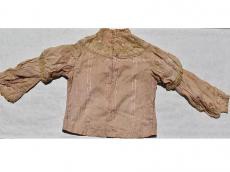|
|
TODAY.AZ / Arts & Entertainment
History Museum restoring Khurshidbanu Natavan's jacket
26 July 2022 [16:14] - TODAY.AZ

By Azernews
By Laman Ismayilova
Khurshidbanu Natavan's handmade jacket is being restored at the National History Museum, Azernews reports, citing the National History Museum.
The restoration is being carried out without dismantling parts of the exhibit. This process is quite difficult for restoration, but only this way can help to preserve the authenticity of the historical object.
The exhibit's restoration is being carried out by the museum's textile restorer Nurida Huseynova.
After the restoration, Khurshidbanu Natavan's jacket will be presented to the public.
Khurshidbanu Natavan was born on August 6, 1832, in the town of Shusha. Being the only child in the family and descending from Panah Ali Khan, she was the only heir of the Karabakh khan, known to the general public as the "daughter of the khan".
She became popular through her relationship-themed ghazals and rubaiyat. Kindness, friendship, humanism, and love were the main themes of Natavan's ghazals.
Her romantic poems express the feelings and sufferings of a woman who was not happy in her family life and who lost her son. She adopted the pen name Natavan, a Persian term meaning "powerless", after her son’s tragic death in 1885.
Some of her known poems are "To My Son, Abbas", "Lilac", and "Beloved One" are still used in folk songs.
In addition to poetry, Natavan was also engaged in painting. She was exceptionally good at pencil sketching and attractive embroidery as well. Her landscape sketches were the first-of-a-kind in European style in Azerbaijani art, which perfectly combined the concepts of the Western and Oriental art forms. Her embroidery works were regarded as masterpieces.
After her father's death, she was closely engaged in philanthropy, promoting the social and cultural development of Karabakh.
Even though she took over the Karabakh Empire at the young age of 13, Natavan successfully established her literary career and managed the responsibilities of developing her native city, Shusha.
She did a lot for the welfare of people, including building waterworks, opening schools, and building hospitals.
Prominent for her charity and social activity, Natavan was the first to provide her home city Shusha with drinking water.
Among her famous deeds was a water pipeline that was first laid down in Shusha in 1883, thus solving the water problem of the townsfolk.
Moreover, she also did a lot for the development and popularization of the famous breed of the Karabakh horses. Karabakh horses from Natavan's stud were known as the best in Azerbaijan. In an international show in Paris in 1867, a Karabakh horse Khan from Natavan's stud received a silver medal.
The daughter of the khan was also active in sponsoring one of the first literary societies. She established the first literary society in Shusha and went on to sponsor several more across the country. Majlis-I Uns (Society of Friends) became a renowned poetic group in Karabakh.
In 1858, the poetess met in Baku with the French writer Alexander Dumas and presented her manual works.
The French novelist is said to have been charmed by her oriental beauty, and literary and artistic talent. As an honored guest at Natavan's family home, he was given a chess set after playing chess with his host.
The Alexandre Dumas Museum in Paris houses a hand-crafted pouch given by Natavan to the French writer when she defeated him in a chess game upon his stay in Shusha during his trip through the Caucasus.
Natavan died in 1897 in Shusha. As a sign of respect, people carried her coffin on their shoulders all the way from Shusha to Agdam, some 30 km northeast, where she was buried in a family vault.
URL: http://www.today.az/news/entertainment/223423.html
 Print version
Print version
Connect with us. Get latest news and updates.
See Also
- 28 February 2025 [14:55]
Leyla Aliyeva, Arzu Aliyeva visit RAK Art Foundation in Bahrain - 28 February 2025 [14:37]
Culture Minister: Historical sites being restored in Garabagh and East Zangazur - 28 February 2025 [13:39]
Khatai Arts Center to host exhibition "Etudes of Absheron" - 28 February 2025 [12:21]
Culture Ministry launches new project focused on journalism - 28 February 2025 [11:27]
Musical-installation performance "Incomplete Weave" held at Azerbaijani Cultural House in Prague - 27 February 2025 [13:19]
Asmar Narimanbayova demonstrate her art piece in Paris - 27 February 2025 [12:13]
Int'l art project MAMA "Mother Nature" for environmental protection presented in Bahrain - 27 February 2025 [10:21]
Crown Prince, Prime Minister of Bahrain receives Heydar Aliyev Foundation's Vice President - 26 February 2025 [17:51]
Reza Deghati's exhibition "Khojaly - Wounded Souls" opens in Baku - 26 February 2025 [17:25]
Seoul hosts second symposium dedicated to Khojaly genocide
Most Popular
 Europe is betting on Azerbaijan: the Green Corridor is reaching a new level
Europe is betting on Azerbaijan: the Green Corridor is reaching a new level
 Scholz calls Merz to discuss US-Ukrainian Summit amid Ukraine crisis
Scholz calls Merz to discuss US-Ukrainian Summit amid Ukraine crisis
 Azerbaijan and Croatia discuss strengthening business ties
Azerbaijan and Croatia discuss strengthening business ties
 Armenian "naivety" and a joke about a chicken
Armenian "naivety" and a joke about a chicken
 Musical-installation performance "Incomplete Weave" held at Azerbaijani Cultural House in Prague
Musical-installation performance "Incomplete Weave" held at Azerbaijani Cultural House in Prague
 Croatia-Azerbaijan Investment Forum set to take place
Croatia-Azerbaijan Investment Forum set to take place
 Azerbaijan, Guinea-Bissau steps into new era of strategic partnership
Azerbaijan, Guinea-Bissau steps into new era of strategic partnership
